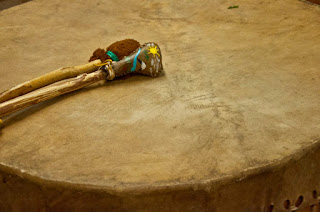Zen is the Japanese term for a form of the Buddhist religion that concentrates on meditation to achieve enlightenment rather than on studying religious writings. Zen Buddhism teaches that contemplation of one's essential nature to the exclusion of all else is the only way of achieving pure enlightenment. Contemplation induces a state of calm attentiveness in which one's actions are guided by intuition rather than by conscious effort. This Zen state of mind can readily be achieved through drumming -- a form of active meditation. Rhythmic stimulation is a simple and effective technique for affecting states of mind.
Taiko is a term that has come to mean a traditional style of Japanese drumming (what the Japanese would refer to as "wadaiko"), but the word actually refers to the taiko drums themselves. Literally, taiko means "fat drum," although there is a vast array of shapes and sizes of taiko. For me, taiko is nothing more that a creative expression and exchange of healing energy. The sound waves created by the drum impart their energy to the resonating systems of the body, mind, and spirit, making them vibrate in sympathy. When we drum, our living flesh, brainwaves and etheric energy field entrain to the sound waves and rhythms. This sympathetic resonance forms new harmonic alignments, opens the body's energy meridians, releases blocked emotional patterns, promotes healing, and helps connect us to our core, enhancing our sense of empowerment and stimulating our creative expression.
Taiko is the relationship of energy between a drummer and a drum, between a drummer and their fellow drummers, and between the drummers and anyone experiencing that drum. Taiko is a very powerful tool for expressing and exchanging energy. Taiko drummers themselves are musical instruments. They employ sticks and drums, but it is their bodies, voices, and life force (ki) that express an exchange of energy. This relationship with energy can be found in anything that one approaches with mindfulness and intention -- other instruments, other arts, or pursuits of any kind. To hear and experience a taiko drum, relax and listen to my latest music release on Spotify -- "Zen Taiko."
Taiko is a term that has come to mean a traditional style of Japanese drumming (what the Japanese would refer to as "wadaiko"), but the word actually refers to the taiko drums themselves. Literally, taiko means "fat drum," although there is a vast array of shapes and sizes of taiko. For me, taiko is nothing more that a creative expression and exchange of healing energy. The sound waves created by the drum impart their energy to the resonating systems of the body, mind, and spirit, making them vibrate in sympathy. When we drum, our living flesh, brainwaves and etheric energy field entrain to the sound waves and rhythms. This sympathetic resonance forms new harmonic alignments, opens the body's energy meridians, releases blocked emotional patterns, promotes healing, and helps connect us to our core, enhancing our sense of empowerment and stimulating our creative expression.
Taiko is the relationship of energy between a drummer and a drum, between a drummer and their fellow drummers, and between the drummers and anyone experiencing that drum. Taiko is a very powerful tool for expressing and exchanging energy. Taiko drummers themselves are musical instruments. They employ sticks and drums, but it is their bodies, voices, and life force (ki) that express an exchange of energy. This relationship with energy can be found in anything that one approaches with mindfulness and intention -- other instruments, other arts, or pursuits of any kind. To hear and experience a taiko drum, relax and listen to my latest music release on Spotify -- "Zen Taiko."






